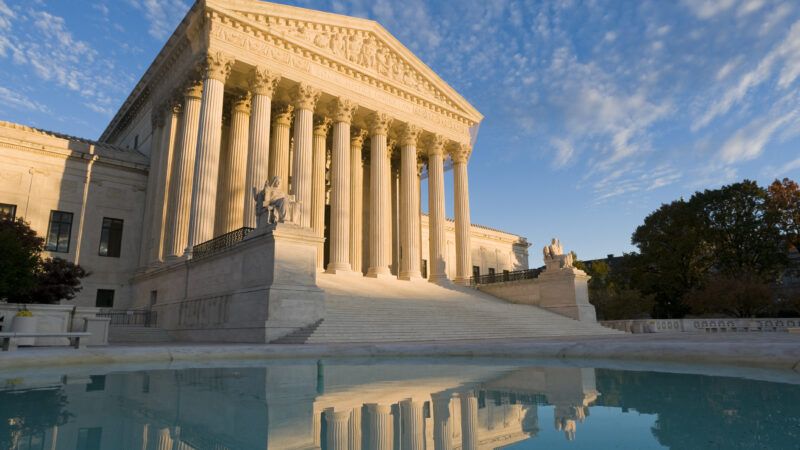Supreme Court Limits EPA's Ability To Impose Costly Greenhouse Gas Emissions Cuts
Any future regulations will require clear authorization from Congress.

The U.S. Supreme Court ruled today in the West Virginia v. Environmental Protection Agency that it "is a major questions case." As such, the Court ruled 6–3 that the Environmental Protection Agency (EPA) did not have clear authority from Congress to regulate the entire U.S. electric power production industry through exercising "unheralded power representing a transformative expansion of its regulatory authority in the vague language" in a rarely used section of the Clean Air Act. This decision will likely curtail future efforts by the Biden administration to significantly cut the emissions of carbon dioxide from fossil-fuel-burning power plants that contribute to man-made global warming.
The background of the case is a bit complicated. Back in 2009, the Obama administration supported cap-and-trade legislation in Congress that aimed to reduce the emissions of carbon dioxide from burning fossil fuels to produce electricity. The American Clean Energy and Security Act passed the House of Representatives but stalled in the Senate. Stymied by inaction in Congress, President Barack Obama subsequently ordered the EPA to regulate power plants under the authority of the Clean Air Act. The agency duly issued in 2015 the Clean Power Plan (CPP) consisting largely of regulations that would establish cap-and-trade emissions markets in each state. The upshot of the CPP was that coal-fired power plants would end up subsidizing renewable energy competitors and eventually would have to shut down because they would not be able to cut their carbon dioxide emissions enough.
In an unusual preemptive move, the Supreme Court ordered in February 2016 the Obama administration to not take any steps to implement the CPP as challenges to the regulations wended their way through the federal courts. In 2017,* President Donald Trump ordered the agency to scrap his predecessor's Clean Power Plan and instead adopt in 2019 a much more restrained Affordable Clean Energy (ACE) Rule that outlined the best systems of emissions reduction of carbon dioxide emissions from individual coal-fired plants. These were essentially equipment upgrades that generate more electricity per ton of coal burned.
On his first day in office, President Joe Biden ordered a review of all Trump administration regulations related to climate change including those issued under the Affordable Clean Energy Rule. In January 2021, the U.S Court of Appeals for the District of Columbia Circuit ruled that the Trump administration's replacement of the CPP with the ACE was "arbitrary and capricious." The majority opinion further held that "the EPA has not just the authority, but a statutory duty, to regulate greenhouse gas pollution, including specifically from power plants." In addition, comprehensive regulatory schemes like those embodied in the CPP are within EPA's scope of authority and do not "trigger the major questions doctrine."
Obviously, the majority of Supreme Court justices have now disagreed with and overruled these conclusions of the D.C. Circuit Court. Absent further clear direction from Congress, the EPA does not have the authority to reorder the entire U.S. electric power sector.
So what is the major questions doctrine? "The Supreme Court has declared that if an agency seeks to decide an issue of major national significance, its action must be supported by clear statutory authorization," explained the Congressional Research Service in a recent analysis. Certainly, the huge costs imposed by new regulations that are not clearly authorized by Congress would seem to qualify as an issue of national significance. In fact, in his majority opinion, Chief Justice John Roberts notes, "EPA's own modeling concluded that the rule would entail billions of dollars in compliance costs (to be paid in the form of higher energy prices), require the retirement of dozens of coal-fired plants, and eliminate tens of thousands of jobs across various sectors."
The chief justice's observation is bolstered by a number of analyses of the previously proposed EPA emissions regulations under the Obama administration's Clean Power Plan that found that they would significantly raise the price of electricity to consumers by nearly 30 percent and cost between $29 billion and $39 billion annually.
In her dissent, Associate Justice Elena Kagan counters by pointing out the Obama administration's EPA calculated that by 2030 the annual public health and climate benefits of proposed regulations under its Clean Power Plan would be between $34 to $54 billion while the costs would amount to $8.4 billion. While electricity would cost more, consumers would save $7 monthly on their electric bills due to increased energy efficiency. A 2016 study in the journal PLOS One similarly found that the health co-benefits outweighed the costs incurred from reducing carbon dioxide emissions.
Despite the fact that the benefits of costly and transformative regulations might outweigh their costs that still does not mean for the Court's majority that their issuance is not a major question requiring clear direction from Congress before going forward.
"Capping carbon dioxide emissions at a level that will force a nationwide transition away from the use of coal to generate electricity may be a sensible 'solution to the crisis of the day,'" concludes Chief Justice Roberts. "But it is not plausible that Congress gave EPA the authority to adopt on its own such a regulatory scheme in [the Clean Air Act]. A decision of such magnitude and consequence rests with Congress itself, or an agency acting pursuant to a clear delegation from that representative body."
*CORRECTION: A previous version of this article misstated the year of the Trump order.

Show Comments (108)